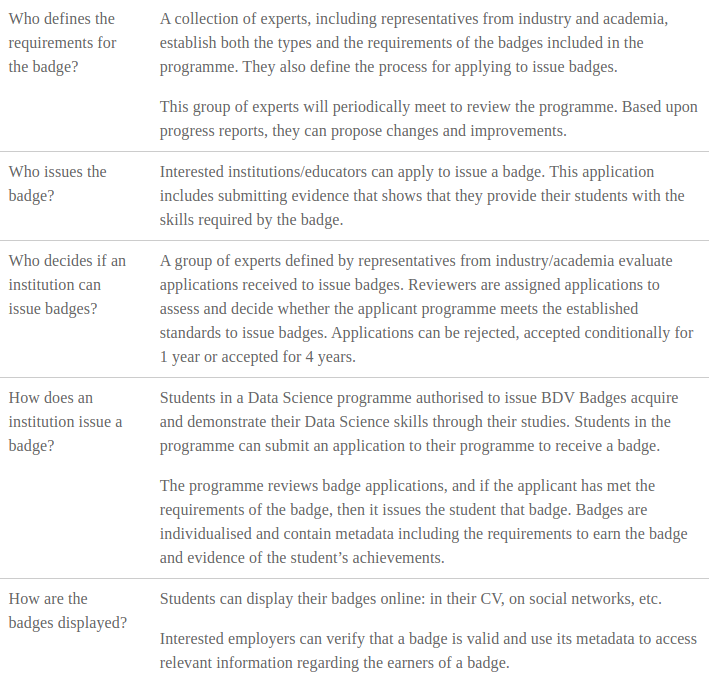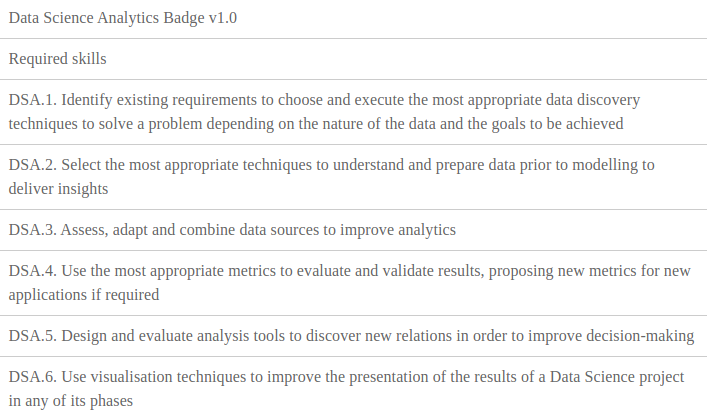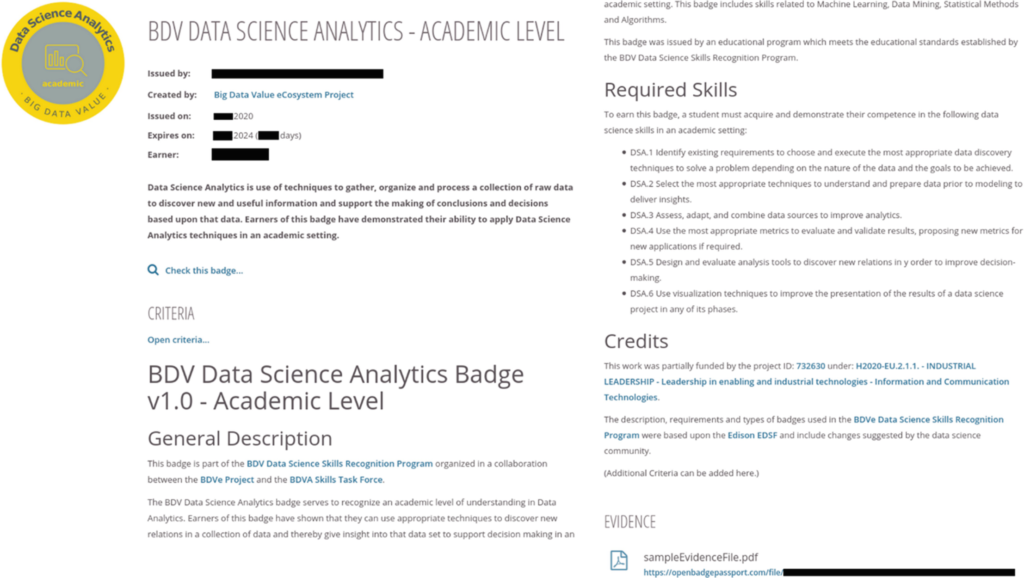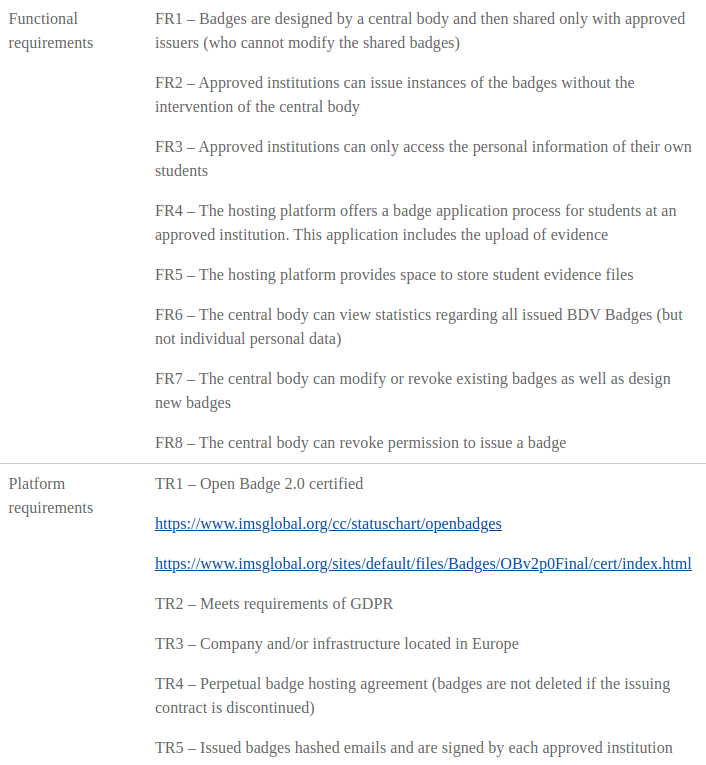Methodology
The recognition strategy proposed by the BDVe for formal education science is based on the use of Open Badges.Open Badges are images that can be included in a curriculum, uploaded to platforms like LinkedIn and shared on social media. They contain metadata to allow:
- The online verification of their authenticity and ownership
- Reviewing information regarding requirements to receive the badge
- Access to details regarding the organisation who issued the badge
- Viewing when the badge was issued and when it expires
- Downloading evidence of the acquisition of skills
The key aspects of the Open Badges recognition schema proposed by the BDVe are detailed in Table 1.

Figure 1 represents graphically the BDV Badge programme proposed. The badges will be designed by a committee of experts from both industry and academia. Institutions will be responsible for issuing the badges (once a review process has been successfully passed) to their students, and they will be able to display their badges online, so employers will have access to the content and thereby verify the Data Science knowledge of the students.

Badge Overview
Based on the EDISON framework, we initially proposed the creation of one group of badges for each competence group, with each group of badges having three levels of proficiency (basic, intermediate and expert). To make the proposal more accessible to a wider audience, we chose to use the term “required skills” in place of “learning outcomes”.Thus, the following is the initial collection of BDV Data Science Badges:
- Data Science Analytics Badge
- Data Engineering Badge
- Data Science Management Badge
- Business Process Management Badge
- Data Science Research Method and Project Management Badge
With the aim of verifying the comprehensibility and utility of this proposal, we conducted an evaluation process which involved both industry and academia. In order to get detailed feedback and make this assessment process effective, in the initial stage, we focused only on the Data Science Analytics Badge. We obtained feedback from 12 companies from industry. The aims were to obtain information about the relevance of the different required skills to their hiring practices and to ensure that the descriptions of the required skills were easy to understand. Fifteen universities were contacted to participate in several rounds of the evaluation. The aim was to get feedback about the review process (specifically the kinds of material to be requested of badge applicants) and about the requirements of the badge. Additionally, the members of the Big Data Value Association (BDVA) Skills and Education Task Force provided feedback on the initial version of the badges as well as on the comments gathered from industry and academia.
Based on the results of the assessment process, the three levels of proficiency (basic, intermediate and expert) were replaced by two levels (academic and professional) having the same required skills. The academic level requires knowledge and training which can be acquired in an academic context, while the professional level requires real professional practice.The description of some of the requirements was also modified, providing the final version of the BDV Data Science Analytics Badge shown in Table 2. Images of both the academic and professional badges are shown in Fig. 2.


Figure 3 shows how the Data Science Analytics Badge of one student could be visualised.

Platform
As mentioned, the proposed recognition framework works with Open Badges. In this section, we address the badge-issuing platform selected. First, we will consider some details of v2.0 of the Open Badge Standard.The most recent version of the technical specifications for Open Badges (v2.0) was published on 12 April 2018. An Open Badge must contain three pieces of linked metadata in JSON-LD:
- Issuer Profile – This resource describes who issued the badge. Usually, one profile is created for each organisation, but it is possible to have multiple issuers (e.g. different departments within the same university).
- BadgeClass – This resource contains information regarding the badge itself and must include information such as the issuer, a description of the badge and the criteria used to issue the badge.
- Assertion – This represents one particular badge (a BadgeClass) issued to one particular person. People can be identified in a number of ways (telephone number, URL), but many badge platforms only accept email identifiers.
From this standard and other considerations specific to the BDV Badge programme, we developed two lists of requirements for the badge-issuing platform. These are summarised in Table 3.

Finally, all Open Badge v2.0-certified badge-issuing platforms were evaluated according to the previous requirements. The issuing platforms assessed were those listed at https://www.imsglobal.org/cc/statuschart/openbadges on 1 February 2019. From them, one that is based in the EU was chosen, which also fulfils the previous criteria.
Excerpt from: Menasalvas E. et al. (2021) Recognition of Formal and Non-formal Training in Data Science. In: Curry E., Metzger A., Zillner S., Pazzaglia JC., García Robles A. (eds) The Elements of Big Data Value. Springer, Cham. https://doi.org/10.1007/978-3-030-68176-0_13